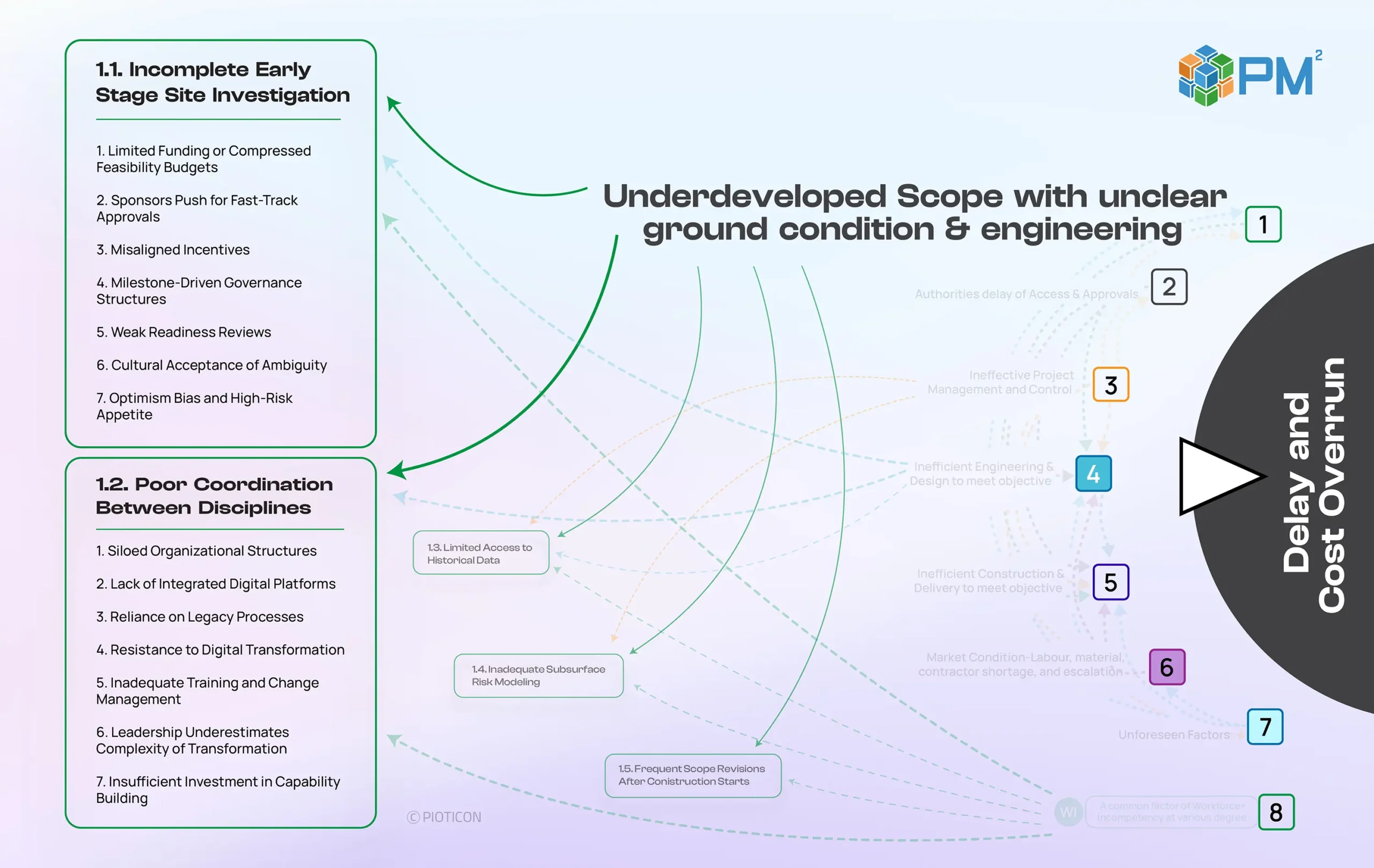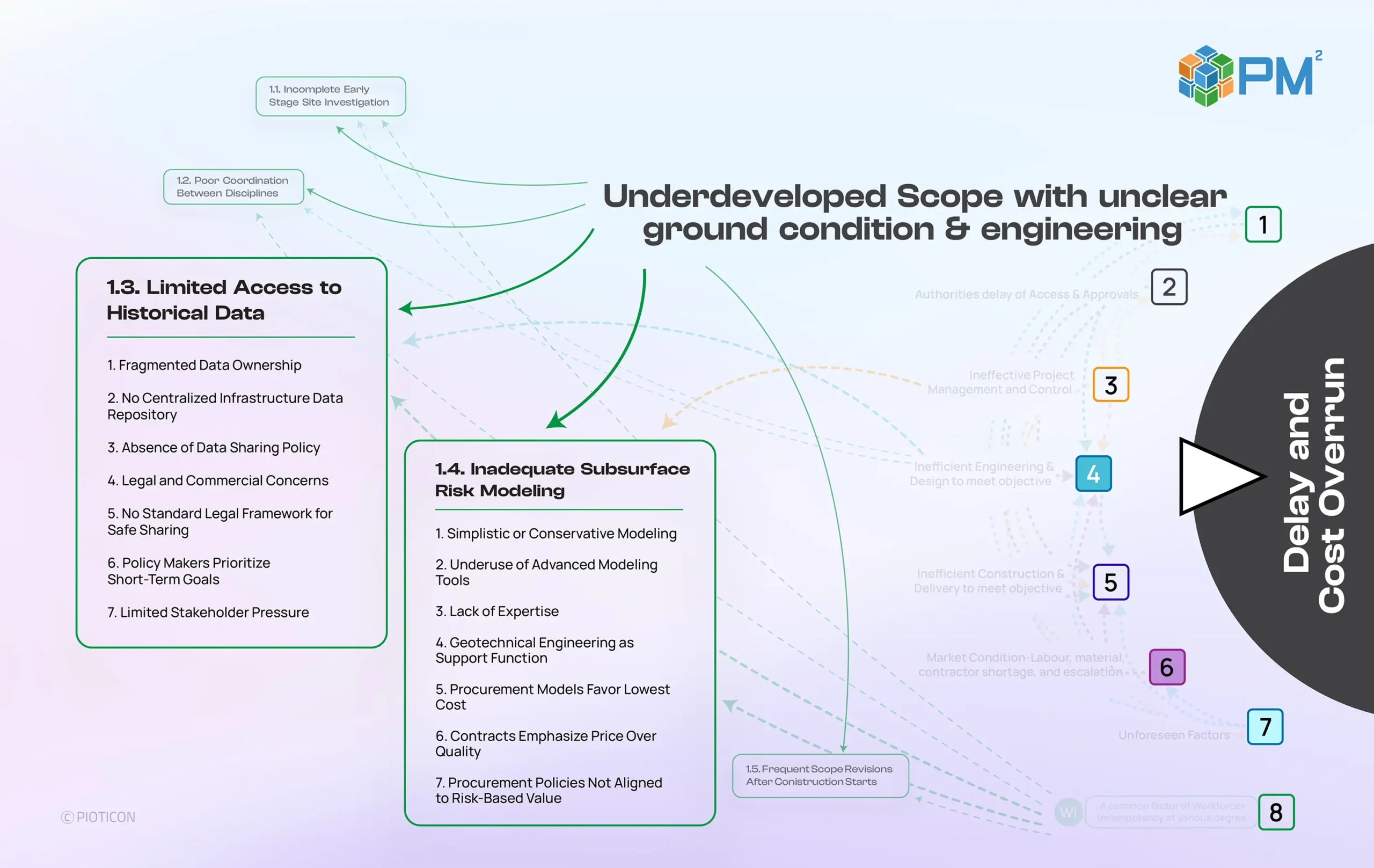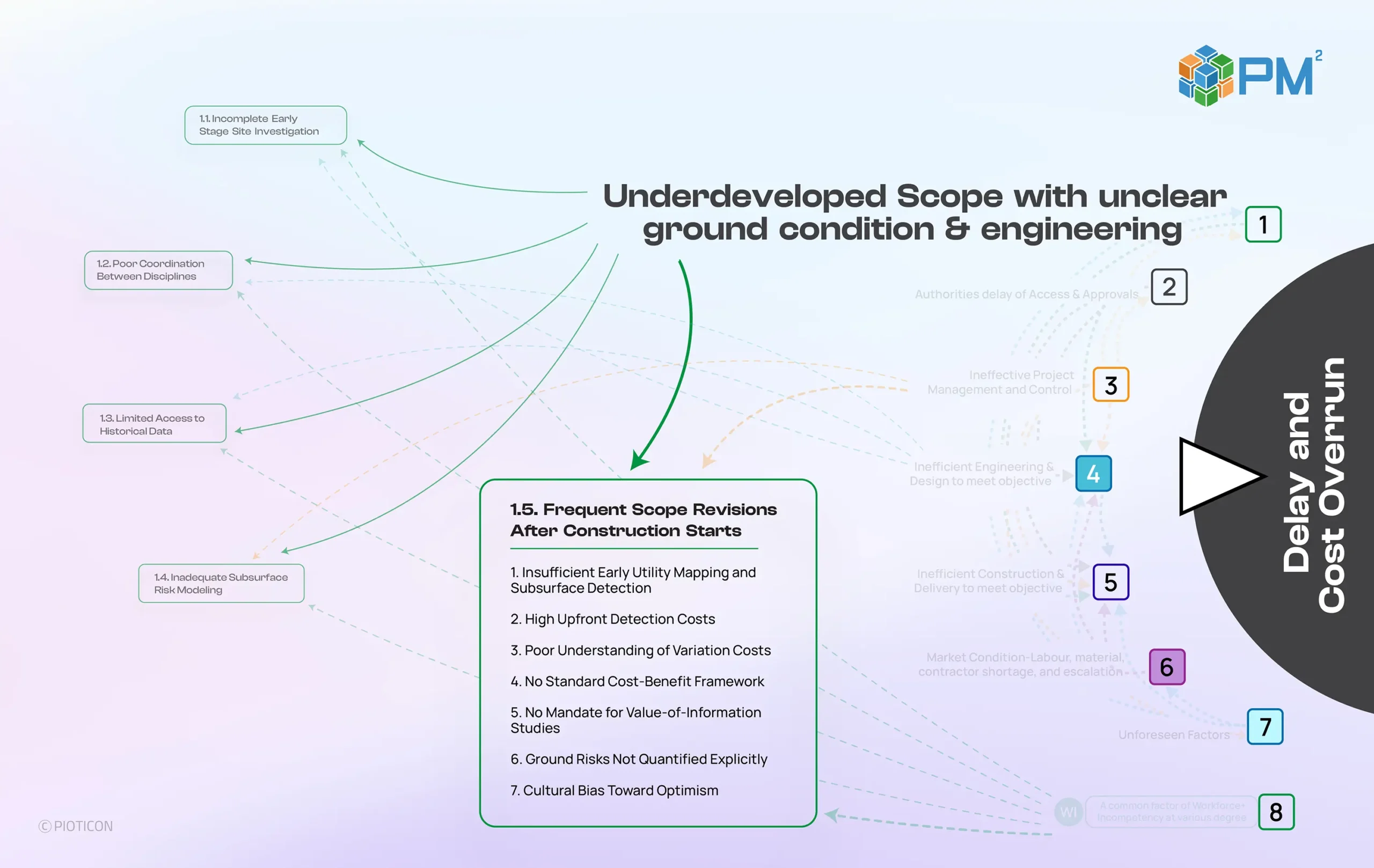- 6 August 2025
- Madan G Anand
- 0
Underdeveloped Scope with Unclear Ground Condition and Engineering: A Deep Dive into Root Causes and Solutions
Major infrastructure projects continue to face one persistent and costly problem: underdeveloped scope combined with unclear ground conditions and immature engineering practices. This issue is not confined to one country or sector; it appears repeatedly across geographies, budgets, and delivery models. Budget overruns, delays, disputes, and even outright failures all trace back to these foundational weaknesses.
The Visible Symptom: Underdeveloped Scope and Unclear Ground Conditions
1.1. Incomplete Early Stage Site Investigation
The Initial Chain of Causes
- Limited Funding and Compressed Budgets Sponsors frequently restrict early-stage spending. Comprehensive site investigations require significant upfront investment, and decision-makers often hesitate to commit before full project approvals.
- Pressure for Fast-Track Approvals Sponsors prioritize early green lights to secure funding or meet political and regulatory promises. Project readiness often takes a back seat.
- Misaligned Incentives Project leaders receive recognition for achieving initial approvals rather than ensuring robust technical readiness. This misalignment pushes teams to rush.
- Milestone-Driven Governance Structures Approval frameworks emphasize stage-gate milestones rather than actual readiness, allowing projects to proceed despite unresolved technical gaps.
- Weak Independent Reviews The absence of strong third-party validations leaves scope and technical assessments unchecked.
- Cultural Acceptance of Uncertainty Many organizations hold a belief that unknowns can be managed later, underestimating future impact.
- Optimism Bias and High-Risk Appetite Overconfidence in later-stage problem-solving often leads to freezing scope prematurely.
The Solution
Front-end loading (FEL) processes with strict readiness criteria set a stronger foundation. Independent scope and site validations before approvals ensure critical risks are addressed. Incentive structures should reward thoroughness and technical quality rather than speed alone.
1.2. Poor Interdisciplinary Coordination
The Fragmentation Challenge
Several reasons drive this fragmentation:
- Siloed Organizational Structures
Departments operate as isolated units, reducing information flow and collaboration. - Absence of Integrated Digital Platforms
Critical data remains trapped in disconnected systems without a unified view. - Legacy Processes
Reliance on outdated document transfers stifles dynamic design evolution. - Resistance to Digital Adoption
Teams often hesitate to embrace new systems like BIM or GIS, viewing them as optional rather than essential. - Inadequate Training and Change Support
Teams receive insufficient guidance and support to adopt new practices effectively. - Leadership Underestimation
Senior leaders sometimes treat digital transformation as an IT task instead of a core strategic shift. - Limited Investment in Capability Building
Budgets focus heavily on delivery at the expense of internal capability and digital maturity.
The Solution
1.3. Limited Access to Historical Data
The Data Deficit
Many projects start without access to valuable data from earlier studies or nearby projects, forcing teams to rebuild knowledge from scratch.
Key reasons for this gap include:
- Fragmented Data Ownership
Data resides across different private and public entities, making access difficult. - Absence of Centralized Repositories
National or regional infrastructure data repositories are rare or nonexistent. - Lack of Policy Frameworks
Without clear regulations, data sharing remains inconsistent and discretionary. - Legal and Commercial Barriers
Concerns around liability and intellectual property discourage open data sharing. - No Standardized Legal Protections
Absence of consistent agreements makes data custodians hesitant to release valuable information. - Short-Term Political Focus
Leaders prioritize quick wins over systemic improvements, leaving data strategies neglected. - Weak Industry Pressure for Reform
Stakeholders rarely push hard enough for collective data sharing reforms.
The Solution
1.4. Inadequate Subsurface Risk Modeling
Blind Spots in Modeling
Key reasons for weak subsurface modeling include:
- Simplistic or Conservative Approaches
Teams may oversimplify or adopt overly cautious assumptions due to confidence gaps. - Underuse of Advanced Tools
Tools, techniques and skills to accurately perform 3D geotechnical modeling and probabilistic risk analysis remain inadequate.
Shortage of Specialized Expertise
Skilled professionals in advanced geotechnical modeling are in limited supply.- Low Priority for Geotechnical Work
Compared to other engineering disciplines, geotechnical input often receives less attention and investment. - Procurement Focus on Lowest Cost
Tender processes reward cheaper options instead of thorough technical analysis. - Contract Evaluations Emphasize Price
Procurement scoring frameworks undervalue technical rigor. - Procurement Misalignment with Lifecycle Risk
Short-term cost focus disregards long-term risk exposure.
The Solution
1.5. Frequent Scope Revisions During Construction
The Cascade of Unknowns
Unforeseen ground conditions force redesigns mid-construction, driving up costs and timelines.
Key reasons for ongoing scope changes include:
- Lack of Early Utility Mapping
Inadequate investment in tools like GPR and LiDAR leaves subsurface surprises. - Reluctance to Spend on Early Detection
Decision-makers consider upfront investigations an unnecessary expense. - Underestimation of Variation Costs
Many organizations fail to appreciate the true cost impact of late-stage changes. - No Structured Cost-Benefit Analysis
Few institutions compare early detection investment against potential redesign costs systematically. - Absence of Formal VOI Studies
Projects rarely quantify the benefits of better information before construction. - Qualitative Treatment of Ground Risks
Risks appear as generic entries in registers without quantified impacts. - Optimism in Early Estimates
Understated risks help secure approvals but undermine delivery integrity.
The Solution
Cross-Cutting Recommendations: Linking Scope to the Wider Delivery System
- Front-End Loading (FEL) and Independent Readiness Reviews Strengthens early project assurance and ensures that authorities’ approvals (Cluster 2) are based on realistic, fully validated baselines, reducing late-stage regulatory challenges.
- Integrated Digital Engineering Platforms and Leadership Alignment Improves coordination between disciplines while simultaneously feeding accurate, real-time data into performance reporting and intelligence systems, breaking silos and enabling predictive insights.
- National Infrastructure Data Repositories and Legal Frameworks Enhances not only early scope development but also supports risk management (Cluster 4) and future project benchmarking, creating an institutional knowledge base for ongoing PMC governance (Cluster 7).
- Advanced Geotechnical Modeling and Risk-Based Procurement Reform Directly improves subsurface risk management while ensuring procurement decisions align with broader integrated project control standards (Cluster 6), preventing lowest-cost bias from undermining delivery.
- Institutionalized Value of Information (VOI) Studies and Quantitative Ground Risk Registers Provides a structured approach to weighing early detection costs against late-stage redesign impacts, directly linking with risk buffers in planning and scheduling (Cluster 3) and ensuring better control over change management (Cluster 1).
Why Integration Matters
Challenge | Solution |
Incomplete Scope | Front-End Loading (FEL), independent readiness reviews, governance reform |
Poor Interdisciplinary Coordination | Integrated digital engineering platforms, capability-building, leadership alignment |
Data Access Gaps | National infrastructure data repositories, legal frameworks for data sharing |
Weak Subsurface Modeling | Advanced geotechnical modeling requirements, procurement reform |
Costly Scope Revisions | Institutionalized VOI studies, quantitative ground risk management |


